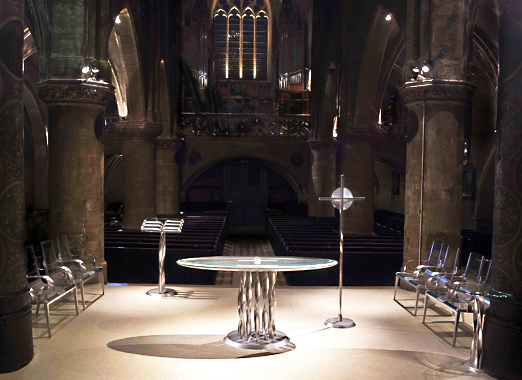
What are the rules when decorating a Church? indesignlive discovers the divine inspiration behind designing ’sacred’ interiors.
indesignlive.com caught up with Frank and Stanimira Rafaschieri from STUDIO DESIGN RAFASCHIERI all the way from France, to find out the almighty rules when designing the interiors for a church. They recently completed an interior fitout in the Heart of the Church of Saint Eucaire, France.
Story continues below advertisement
“We began this project with passion, but with great caution for fear not to go against the Holy Scriptures. Our approach is an intention, at best hope to gather material and spiritual expression in a plastic, give body and soul to a work liturgical representative of our time.
We were inspired by the apocalyptic reasons, and symbolic revealing passages of the New Testament. The study of many texts pushed us to look beyond the visible, where we only deal with the mystery of God.
Story continues below advertisement
In the tables, living water flowing magnificent fountains in the middle of a garden paradise. There is a parallel with the tree of knowledge of heaven on earth. In the project design, we sought to represent water, and valuable source of life, raised several times in the texts.
The spiral reveals natural impulses crossing humans and unite the laws of the universe. It is a dynamic form which is increasing its own energy.
Story continues below advertisement
Loaded with symbolism, it is seen as complementary element of the architecture. It provides a bridge while evading the cutaways. Between the vertical and horizontal, this archetype can be found in the branches of trees, in the escape of water in the clouds, and devastating power of tornadoes and hurricanes, in our twisted muscles in human DNA.
The pedestal of torsades furniture in the space designate a movement, an elevation. The alternation of elements and the appearance of the material used help in the search for transparency integrating all in the heart of the church.
We took as a reference the Last Supper, the last meal that Jesus took with his disciples on the eve of the Passion, painted by Leonardo da Vinci and repeated in the history of art by many other painters, this very long table where Christ is the center and his apostles on either side. We imagined the altar as a table elongated representing Christ welcoming us with open arms.
The pulpit, designed in the same vein as the formal altar rises to the top. We used to draw the spiral vibrations of sound waves, to discuss the scope and depth of the voice of God, who teaches the Faith. Through its components and twisted corrugated we translate the Alpha and Omega, infinity.
There is a significant link between the altar and pulpit, its two poles, the celebration of the Eucharist and the proclamation of the word of God. The Apocalypse describes a “biblion,” sealed a roll of seven seals that only the Lamb may break. The opening of seven seals attributed to Christ the central role.”